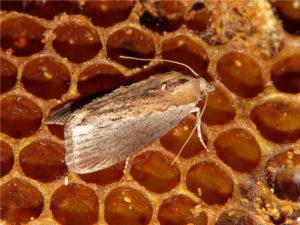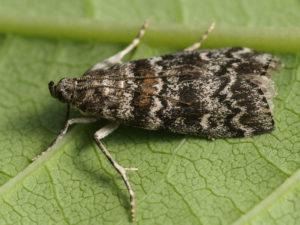Gooseberry moth and 2 more types of dangerous inconspicuous butterflies
The flame always appears to us as a moth. But its caterpillars also do a lot of harm, and the larvae can be useful. Consider this controversial butterfly from two sides.
Content
What does the fire look like (photo)
Description of the wax moth
Name: fireflies
Latin:PyralidaeClass: Insects - Insecta
Squad: Lepidoptera - Lepidoptera
Family: Fireflies - Pyralidae
 | Habitats: | garden and vegetable garden, forest, planting |
 | Dangerous for: | many green spaces |
 | Means of destruction: | chemicals, folk methods |
There are 2 types of moths. The first variety includes large wax. Its dimensions vary between 3,5 - 3,8 cm. Moths - the second species (small bees) barely reach 2,4 cm.
The front wings are small grey-brown. The larger variety is distinguished by brownish-gray or brownish-yellow wings. The hindwings are cream in large specimens and silvery white in small ones.
What is the harm from the fire in the hive
Caterpillars inhabit bee hives. They initially use honey and bee bread. Then they begin to feed on wax combs. Caterpillars form tunnels and move along them, defecating and highlighting a thin cobweb. The web seals the comb, preventing the bees from depositing honey.
Methods for the destruction of bee moth
There are a number of methods that allow you to remove moths from hives and save bees. Some are gentle, while others are quite extreme.
Safe folk methods
| Mechanical | Honeycombs with a pest must be carefully removed by tapping. Pests crumble, they need to be collected and destroyed. |
| Vinegar | The moistened cloth or cotton wool is placed on the honeycombs and wrapped with a film. The effect will be in 3 days, but you will have to repeat. |
| Temperature | You can freeze honeycombs for 2 hours at a temperature of -10 degrees or more. If you take a high - +50 minimum. |
| Naphthalene | An unpleasant smell repels the moth, like any other moth. Bees do not suffer from aroma. It's best to start in the spring. |
| combustible sulfur | Sulfur fumigation should be carried out every 10-14 days to destroy all pests. Be sure to ventilate the cells. |
Special drugs
Two different means according to the scheme of action are the most effective.
Gooseberry and currant fire
Dangerous representatives of pests are currant and gooseberry moth. The middle and northern strip of the Russian Federation is a habitat. Gooseberries are the favorite food of insects. However, currants and even raspberries are also consumed. On the berries you can see dark spots that rot.
It is a gray butterfly with a front pair of wings that have brown stripes and white scales. The hind wings of the currant moth are lighter with black edging. Caterpillars are bright green with dark blurred stripes. The pupa is brown.
Stages of development
The pupa hibernates in a web nest located at the base of the bush. Before flowering, gray moths appear, which make a clutch. The clutch contains up to 200 eggs. Caterpillar development takes up to 30 days. The size reaches 1,8 cm.
Preventive measures
Very often, when picking the first berries, you can find thick caterpillars. If they are not eliminated, they will destroy most of the crop. Suitable for prevention:
- elderberry and tomato. Branches of elderberry are cut and placed in a container with water. Placed among the bushes of gooseberries and currants. In the same way it is necessary to place the tomatoes. Repeat the process for 3 years;
- compositions that have insecticidal action. Processed when berries are formed;
- mulching of soil. Before flowering, the ground is covered with mulch (a layer of about 10 cm). Apply compost, rotted sawdust, peat.
Folk methods of struggle
Here is a list of proven folk remedies that are sure to work. But often they will need to be used several times.
A tincture with coniferous extract is especially effective. 0,2 kg of pine or needles are mixed with 2 liters of hot water. Leave for 7 days. Add to 10 liters of water and spray.
You can take dry mustard 0,1 kg. Add to bucket of water. Leave for 2 days. After that, strain and process the bushes.
Ash shows a quick result. 1 kg is poured into 5 liters of water. Next, you need to boil for half an hour. After cooling and straining, you can apply.
It is useful to treat the soil with a dust solution (12%). Before opening the buds, the powder is poured under the bushes.
Road dust is also mixed with pyrethrum in a ratio of 2: 1 and sprayed. Repeat the procedure after 5 days.
After the start of flowering, you can treat with pharmacy chamomile. 0,1 kg of dried plants are added to a bucket of hot water and processed.
Chemical methods
There is a very fast result using chemical compounds:
- "Aktellika";
- "Etaphos";
- "Karbofos".
cone fire
The pest destroys coniferous trees. The larvae of the cone moth eat young shoots, which slows down the growth of the young plant and development. Infected needles dry out and the cones fall off. Etched scales are visible on the cones. Basically, the larvae feed on pine, larch, fir, and cedar pine.
A small butterfly has an elongated body and a cone-shaped head. The hindwings are whitish-grey. The front wings are gray in color and have a dark border. The pupa barely reaches 10 mm. Has a light brown or dark brown color.
Life cycle
- During the mating season, females lay up to 5 eggs.
- The eggs are yellowish-red in color.
- After 2 weeks, large, reddish-brown larvae appear, with dark stripes on the side. They eat scales and shoots without touching the stem.
- Having absorbed nutrients, the pupation stage begins.
- Wintering occurs in a cobweb cocoon.
Methods of struggle
The methods include:
- spraying with chemicals;
- tree pruning;
- product of deep digging.
Also used drugs "BI-58" and "Rogor-S". They spray the crowns of conifers.
Conclusion
Fireflies are great pests. They can cause damage to agriculture, damage to vegetable plantings and bushes. When pests appear, they must be destroyed. You can choose any of the listed methods. But some of them are useful.
Previous
